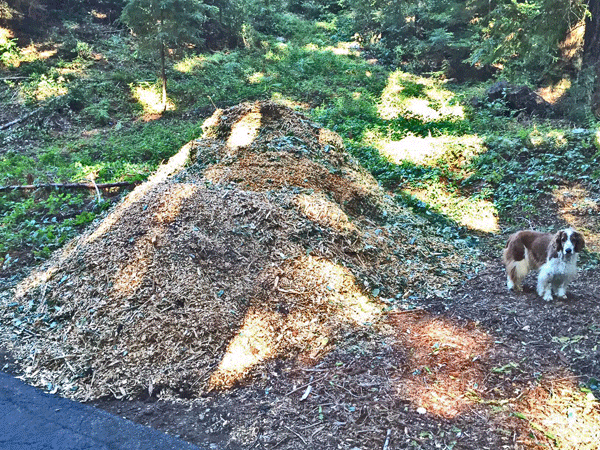With summer winding down I’m looking at my garden and thinking about change. What can I do this fall so that next year I can save more water and make the garden more beautiful?
With our shifting climate and availability of resources, we learn new ways to keep our gardens thriving. Mulching is one way to do it. Cover all bare soil with mulch: mulch your garden, mulch your hillside, mulch your trees, mulch around your perennials and shrubs.
A nice layer around plants conserves moisture, keeps roots cool and encourages microorganisms to flourish in the soil. An added benefit is that it prevents erosion which might be especially important this winter. Protect your soil from runoff with three inches or more of mulch.
I had Davey Tree drop off a load of wood chips recently and the quality was excellent. The chips are small with a few green leaves and will look great as soon as they are spread. There are other sources of mulch and they’re all good. Replenishing mulch is an ongoing task — one that keeps on giving.
While up in the Pacific Northwest recently, I saw many of the same problems and effects of the drought that we are encountering. You can see native trees suffering there as well as the ornamental trees in residential landscapes. No one up there is used to watering a tree in the summer.
The moral of the story is: do not let this happen to your trees. Use a soaker hose, deep root irrigator or a hose turned on slowly to occasionally moisten the soil 18” deep under the drip line and a bit beyond. Even our native oaks can use a drink after four years of drought. Just be sure to keep the trunk area dry. The feeder roots are way out at the edge of the canopy.
You might also be noticing deciduous trees that are already starting to show fall color. This is a survival mechanism. It’s to their benefit to drop foliage prematurely when moisture is scarce. From their point of view, reproduction is over for the year and they can rest up and regroup for next year.
Our native redwoods are showing signs of the drought as the heat of summer take its toll. You can see older, interior needles and small branches die off and start to drop. This happens every year about this time but this year I’m seeing more brown branches than ever. The world’s tallest tree can live for 2,200 years. The age of these trees at maturity is 400-500 years, so most of them have survived other droughts as well.
Coast redwoods prefer to have a full canopy right to the ground and its own, thick mulch layer surrounding the trunk. Redwoods on hot, south facing slopes seem to be suffering more than other redwoods this year. I’ve also seen small patches of redwood trees that appear to have totally died off. Redwoods are usually resistant to disease but drought-stressed trees can suffer from several pathogens and fungal diseases are exacerbated by stress. Some pathogens have been particularly active in the last several drought years. It is not uncommon, however, to find healthy trees in the same vicinity that do not show any signs of disease.
If you are looking for the perfect drought tolerant flower for your late summer garden, you can see them blooming everywhere these days. I’m talking about those huge pink flowers on tall stems that emerge from the ground almost mysteriously at this time of year. Their bare two to three foot stalks rise from bare earth, each topped by a cluster of fragrant, trumpet-shaped rosy pink flowers.
Amaryllis belladonna lends drama and color to the late season garden. Even their common name — Naked Lady — sounds exotic. They are so plentiful many people think they are native to the area. Having a long lived bulb, it is more likely they were brought here by early settlers.
Native to South Africa, amaryllis belladonna performs best is areas with warm dry summers like ours. Growing in most soils with reasonable drainage, they get all the moisture they need from winter rains. Heat and dryness during late spring and summer are necessary for blooming.
Because moving a belladonna lily can easily stop its blooming for several years, it is best to divide clumps only when necessary or to move them during or just after blooming, keeping as much soil intact around the bulb as possible.
The strongly scented flower clusters make an excellent cut flower and last for about a week. A word of caution — the plants are poisonous if eaten. You can find the huge bulbs at local nurseries or ask a neighbor who wants to divide theirs to share.
–Jan Nelson, a landscape designer and California certified nursery professional, will answer questions about gardening in the Santa Cruz Mountains. E-mail her atja******@*ol.com, or visitwww.jannelsonlandscapedesign.comto view past columns and pictures.












